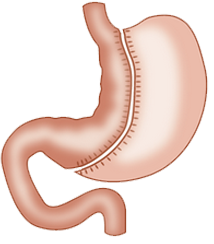Principles
This procedure involves removing two-thirds of the stomach, including the outer part (the most distensible) and the one containing the cells that secrete Ghrelin (an appetite-stimulating hormone). The stomach left in place is thus reduced to a vertical tube with a capacity of 100 to 150 ml.
This does not result in malabsorption. It leads to a reduction in food intake due to three mechanisms:
-
A reduction in the secretion of Ghreline which leads to a marked decrease or sometimes a disappearance of the feeling of hunger,
-
A reduction in gastric capacity,
-
Accelerated gastric emptying causes earlier secretion of satiety hormones (PYY and GLP1).


Benefits
- No foreign body implantation
- Very good food comfort compared to the gastric band
- Pylorus is preserved, resulting in a near-zero risk of dumping syndrome.
- No malabsorption therefore little risk of deficiency and little impact on the effectiveness of drug treatments especially birth control pills.
- The bile ducts remain accessible for endoscopic investigations.
- The small intestine is respected so no risk of occlusion
- Rapid and significant weight loss comparable to that obtained after gastric bypass
- In case of weight gain the sleeve can easily convert to another type of procedure (gastric bypass, duodenal switch, etc.). It can also be redone when weight gain is linked to gastric tube dilation.
Disadvantages
-
Irreversible intervention due to gastrectomy
-
Lifetime vitamin B12 supplementation as after any gastrectomy
Compared to the gastric bypass the sleeve allows a similar weight loss but with a lower risk of deficiencies and long-term complications.

